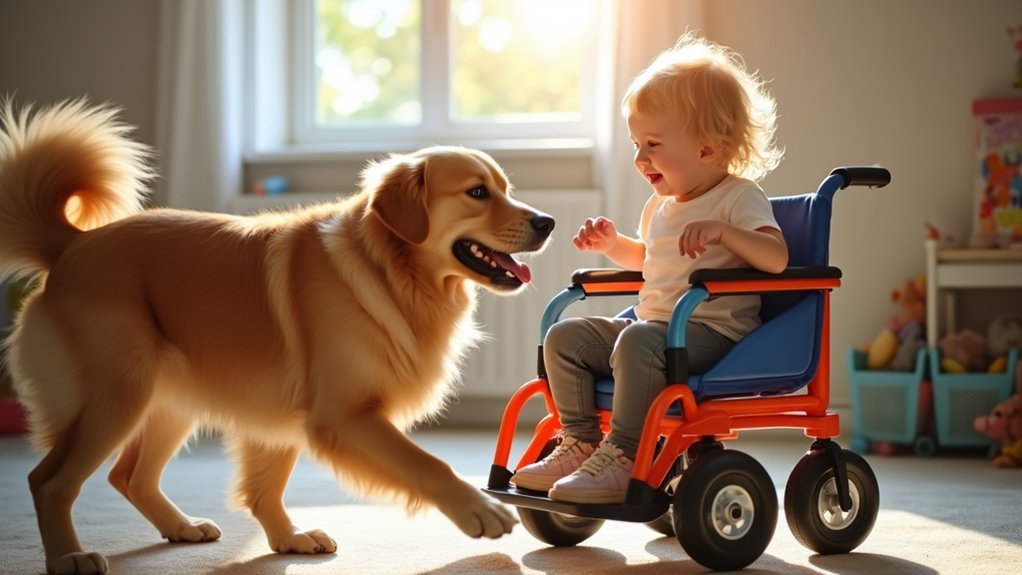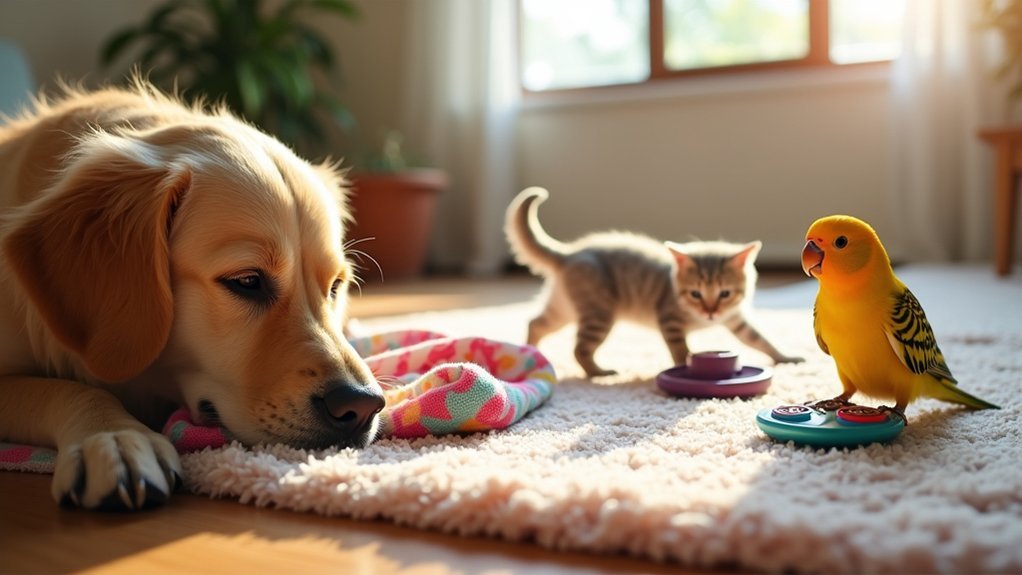Animals help therapy equipment work better in three key ways: First, they transform equipment use from an obligation to an engaging partnership by providing emotional reinforcement. Second, their calming presence reduces anxiety, improving focus and compliance with treatment protocols. Third, pet-integrated mobility devices create supportive environments while reducing strain on both patients and animals. These connections make rehabilitation more effective and enjoyable—there’s much more to discover about this powerful therapeutic alliance.
Animals as Motivational Partners for Adaptive Equipment Engagement

When animals are introduced into therapeutic settings, they transform the experience of using adaptive equipment from a clinical obligation into an engaging partnership.
You’ll notice your motivation to use adaptive tools increases markedly as animals provide emotional reinforcement during challenging sessions.
Animals create natural social bridges between you and your therapist, making equipment use feel less clinical and more conversational.
They help establish consistent routines around your adaptive technology, turning potentially frustrating learning experiences into anticipated interactions.
The reward mechanism is particularly effective—knowing you’ll get to play with a therapy dog after completing exercises with your adaptive equipment provides immediate positive reinforcement.
This emotional connection fosters long-term commitment to your therapy goals, increasing the likelihood you’ll continue using essential adaptive tools independently.
For individuals with temporary or chronic disabilities, incorporating pets into your therapy regimen can create a more client-centered approach that respects your unique needs and abilities.
Therapy Animals Enhancing Focus and Compliance With Rehabilitation Devices
Because therapy animals create a unique calming presence, they greatly enhance your ability to focus during rehabilitation sessions with complex devices. When you’re working with therapeutic equipment, the companionship of animals reduces anxiety and creates a positive environment that improves your compliance with treatment protocols. Animal therapy is particularly effective for those with mental health issues, helping patients engage more consistently with their treatment equipment.
| Animal Type | Focus Benefit | Device Compliance Impact |
|---|---|---|
| Dogs | Reduce PTSD symptoms | 40% increase in exercise duration |
| Cats | Lower stress hormones | Better adherence to home therapy |
| Horses | Improve body awareness | Enhanced motor control with devices |
| Birds | Provide sensory stimulation | Longer attention spans during therapy |
You’ll notice cognitive improvements when animals are present during rehabilitation, as they provide meaningful distractions from discomfort while maintaining your engagement with therapeutic equipment. This partnership transforms potentially frustrating therapy sessions into more enjoyable, productive experiences.
Pet-Integrated Mobility Equipment: Transforming Therapy Experiences

Pet-integrated mobility equipment represents a revolutionary advancement in animal therapy, building upon the benefits animals provide in rehabilitation settings.
These specialized mobility slings, harnesses, and assistive devices offer essential stability while reducing strain on both pets and handlers during therapeutic sessions.
You’ll find these tools enhance therapy experiences by creating emotionally supportive environments where animals feel secure and engaged.
The customized approach—developed through collaboration between veterinarians and rehabilitation therapists—ensures each pet receives tailored support addressing their unique needs.
The integration of these devices extends beyond professional settings, allowing for continued therapy at home. These innovations particularly benefit seniors in healthcare facilities, promoting light physical activity that helps manage physical ailments while improving motor skills.
As technology advances, you can expect to see increasingly sophisticated mobility equipment that further transforms pet therapy experiences, making rehabilitation more accessible, comfortable, and effective for animals with mobility challenges.
Frequently Asked Questions
How Are Therapy Animals Trained to Work With Medical Equipment?
You’ll train therapy animals through positive reinforcement like clickers and treats. They’re taught to remain calm around medical equipment, avoid disturbing IV poles, navigate wheelchairs, and stay composed during procedures and emergency alarms.
Are Certain Animal Species More Effective With Specific Therapy Devices?
Yes, you’ll find that certain animals excel with specific therapy devices. Dogs enhance social interaction tools, rabbits work well with stress reduction devices, and cats’ purring complements sensory integration equipment, creating more effective therapeutic outcomes.
Can Allergic Patients Still Benefit From Animal-Assisted Equipment Therapy?
Yes, you can still benefit from animal-assisted therapy even with allergies. Robotic therapy animals, virtual reality avatars, and hypoallergenic equipment provide similar stress reduction and psychological benefits without triggering allergic reactions.
What Safety Protocols Exist When Animals Interact With Electrical Therapy Equipment?
When animals interact with electrical therapy equipment, you’ll find protocols like pre-assessments, handler supervision, leash requirements, and equipment covers. You should also follow disinfection procedures, equipment checks, and emergency protocols to guarantee everyone’s safety.
How Is Animal Welfare Maintained During Extended Therapy Equipment Sessions?
You’ll maintain animal welfare during extended sessions by enforcing strict time limits, scheduling rest breaks, monitoring for stress signs, providing regular grooming, and removing animals immediately if they show fatigue or distress.
In Summary
You’ve seen how animals transform therapy through motivation, enhanced focus, and integration with equipment. When you’re working with patients who need that extra boost, don’t overlook our furry allies. They’re not just companions—they’re therapeutic catalysts making equipment more effective and treatments more engaging. Consider incorporating animal assistance into your practice for better outcomes and more meaningful rehabilitation experiences.





Leave a Reply